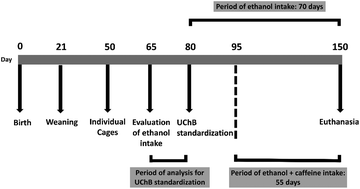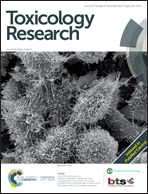Serum miRNAs are differentially altered by ethanol and caffeine consumption in rats
Abstract
Alcoholism is a multifactorial disease with high risk for dependence determined by genetic background, environmental factors and neuroadaptations. The excessive consumption of this substance is related to psychiatric problems, epilepsy, cardiovascular disease, cirrhosis and cancers. Caffeine is one of the most popular psychostimulants currently consumed in the world. The combination of ethanol and caffeine ingested by consuming “energy drinks” is becoming increasingly popular among young people. We analyzed the effect of simultaneous consumption of ethanol and caffeine on the serum profile of miRNAs differentially expressed in the ethanol-drinking rat model (UChB strain). Adult rats were divided into three groups (n = 5 per group): UChB group (rats fed with 1 : 10 (v/v) ethanol ad libitum); UChB + caffeine group (rats fed with 1 : 10 (v/v) ethanol ad libitum + 3 g L−1 of caffeine); control group (rats drinking water used as the control for UChB). The treatment with caffeine occurred from day 95 to 150 days old, totalizing 55 days of ethanol + caffeine ingestion. The expressions of microRNAs (miR) -9-3p, -15b-5p, -16-5p, -21-5p, -200a-3p and -222-3p were detected by Real Time-PCR (RT-PCR). The expressions of miR-9-3p, -15b-5p, -16-5p and -222-3p were upregulated in the UChB group. Conversely, simultaneous ingestion of ethanol and caffeine significantly reversed these expressions to similar levels to control animals, thus emphasizing that caffeine had a protective effect in the presence of ethanol. In addition, miR-21-5p was downregulated with ethanol consumption whereas miR-222-3p was unchanged. Ethanol and caffeine consumption was capable of altering serum miRNAs, which are potential biomarkers for the systemic effects of these addictive substances.



 Please wait while we load your content...
Please wait while we load your content...